 |
| Dorothy Brett Massacre in the Canyon of Death: Vision of the Sun God 1958 oil on board Tate Gallery |
 |
| Ceri Richards Trafalgar Square, London 1950 oil on canvas Tate Gallery |
 |
| Morris Graves Spring with Machine-Age Noise No. 1 1957 tempera on paper Tate Gallery |
from The Visionary Painting of Morris Graves
"Jacques Maritain asks somewhere, "What kept Europe alive for so long after it had obviously been stricken with a fatal disease?" and answers his question, "The prayers of the contemplatives in the monasteries." I am not prepared to enter into a metaphysical defense of petitionary prayer, or a sociological one of monasticism, but the empirical evidence for the social, perhaps even biological necessity for contemplation, is, in these apocalyptic hours, all too obvious. Civilizations endure as long as, somewhere, they can hold life in total vision. The function of the contemplative is contemplation. The function of the artist is the revelation of reality in process, permanence in change, the place of value in a world of facts. His duty is to keep open the channels of contemplation and to discover new ones. His role is purely revelatory. He can bring men to the springs of the good, the true, and the beautiful, but he cannot make them drink. The activities of men endure and have meaning as long as they emanate from a core of transcendental calm. The contemplative, the mystic, assuming moral responsibility for the distracted, tries to keep his gaze fixed on that core. The artist uses the materials of the world to direct men's attention back to it. When it is lost sight of, society perishes."
– Kenneth Rexroth, published in Perspectives USA #10, 1955
 |
| Keith Vaughan Demolished Houses in St John's Wood No. 2 1953 gouache on paper Tate Gallery |
 |
| Maria Helena Vieira da Silva Paris 1951 oil on canvas Tate Gallery |
 |
| Victor Pasmore Square Motif, Blue and Gold: The Eclipse 1950 oil on canvas Tate Gallery |
 |
| Claude Rogers Eclipse at Blandford 1952 oil on canvas Tate Gallery |
 |
| Winifred Nicholson The Hunter's Moon 1955 oil on canvas Tate Gallery |
 |
| Christopher Chamberlain The Dangerous Corner 1954 oil on board Tate Gallery |
 |
| Charles Mahoney Wrotham Place from the Garden ca. 1952-68 oil on canvas Tate Gallery |
 |
| Alan Reynolds Summer: Young September's Cornfield 1954 oil on hardboard Tate Gallery |
 |
| Dennis Creffield Isle of Dogs from Greenwich Observatory 1959 oil on board Tate Gallery |
from The Shape of Content
"I do not at all hold that the mere presence of content, of subject matter, the intention to say something, will magically guarantee the emergence of such content into successful form. Not at all! How often indeed does the intended bellow of industrial power turn to a falsetto on the savings bank walls! How often does the intended lofty angels choir for the downtown church come off resembling somehow a sorority pillow fight! For form is not just the intention of content; it is the embodiment of content. Form is based, first, upon a supposition, a theme. Form is, second, a marshaling of materials, the inert matter in which the theme is to be cast. Form is, third, a setting of boundaries, of limits, the whole extent of idea, but no more, an outer shape of idea. Form is, next, the relating of inner shapes to the outer limits, the initial establishing of harmonies. Form is, further, the abolishing of excessive content, of content that falls outside the true limits of the theme. It is the abolishing of excessive materials, whatever material is extraneous to inner harmony, to the order of shapes now established. Form is thus a discipline, an ordering, according to the needs of content."
– Ben Shahn, The Shape of Content (Harvard University Press, 1957)
 |
| André Masson Riez 1953 oil on canvas Tate Gallery |
 |
| Milton Avery Yellow Sky 1958 oil on canvas Tate Gallery |